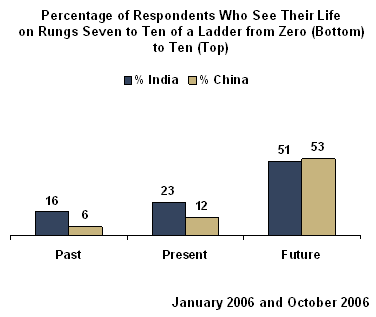GALLUP NEWS SERVICE
WASHINGTON, D.C. -- Among the world's oldest civilizations, China and India have endured periods of occupation, colonization and expansion, and today comprise the two largest populations in the world. Both nations are rapidly modernizing and have experienced tremendous economic growth in the past decades while choosing different paths toward development. China pushes reforms at lightning speed, while India is more deliberate. China's economic reforms have been in place longer, with growth rates outpacing those in India. Despite these differences, both countries have experienced remarkable reductions in poverty and increases in middle class populations in recent years.
Measures of well-being collected by the ║┌┴¤═° World Poll reveal differences in how reform and growth appear to be affecting everyday life for each population. Of those surveyed, the Chinese (84%) were more likely than Indians (56%) to say that they were able to spend their time the day before the survey as they pleased. More Chinese than Indians said they were treated with respect the previous day (85% versus 69%, respectively), and more were proud of something that they accomplished that day (40% versus 33% of Indians). The Chinese were also more likely to indicate that they felt happy the previous day: 78% said they smiled or laughed a lot that day (compared to 62% of Indians), and 81% said they experienced a lot of enjoyment (compared to 72% of Indians).

In other areas, however, Indians seemed more positive. Fewer Indians (12%) than Chinese (21%) claimed to have experienced a lot of boredom on the day preceding the survey, while more Indians (64% versus 51% of Chinese) said that they ate good tasting food the day before the survey. Slightly more Indians (65%) than Chinese (58%) said they would like to have more days just like yesterday.

Interestingly, the Chinese were more likely to express optimism about the near-term future than their Indian counterparts were. When asked to rate their current lives on the Cantril Self-Anchoring Striving Scale with steps numbered from zero (bottom) to ten (top), more Indian respondents placed their life on one of the top four rungs -- 23% did so, versus 12% of Chinese. However, when asked to predict the status of their lives five years from now on the same scale, slightly more than half of the Chinese (53%) and Indian (51%) respondents predicted that they would be on one of those top four rungs.

Looking at results within the populations of each country also reveals some interesting differences. For example, urban Indians are more likely to rate the current (34%) and future (63%) status of their lives higher than their rural counterparts (current status 18% and future status 45%). In China, younger people are most likely to express optimism for the future of their country than older people. (Seventy percent of 15- to 24-year-olds, 67% of 25- to 34-year-olds, 52% of 35- to 44-year-olds, 45% of 45- to 54-year-olds, and 44% of those 55 and older expressed optimism for the future of their country.)
Survey Methods
Results are based on face-to-face interviews with a representative sample of 3,730 residents of China and 2,100 residents of India, aged 15 and older. The China survey was conducted in October of 2006, and the India survey was conducted in January of 2006.
For results based on this sample, one can say with 95% confidence that the maximum error attributable to sampling, weighting, and other random effects is ┬▒3 percentage points. In addition to sampling error, question wording and practical difficulties in conducting surveys can introduce error or bias into the findings of public opinion polls.
